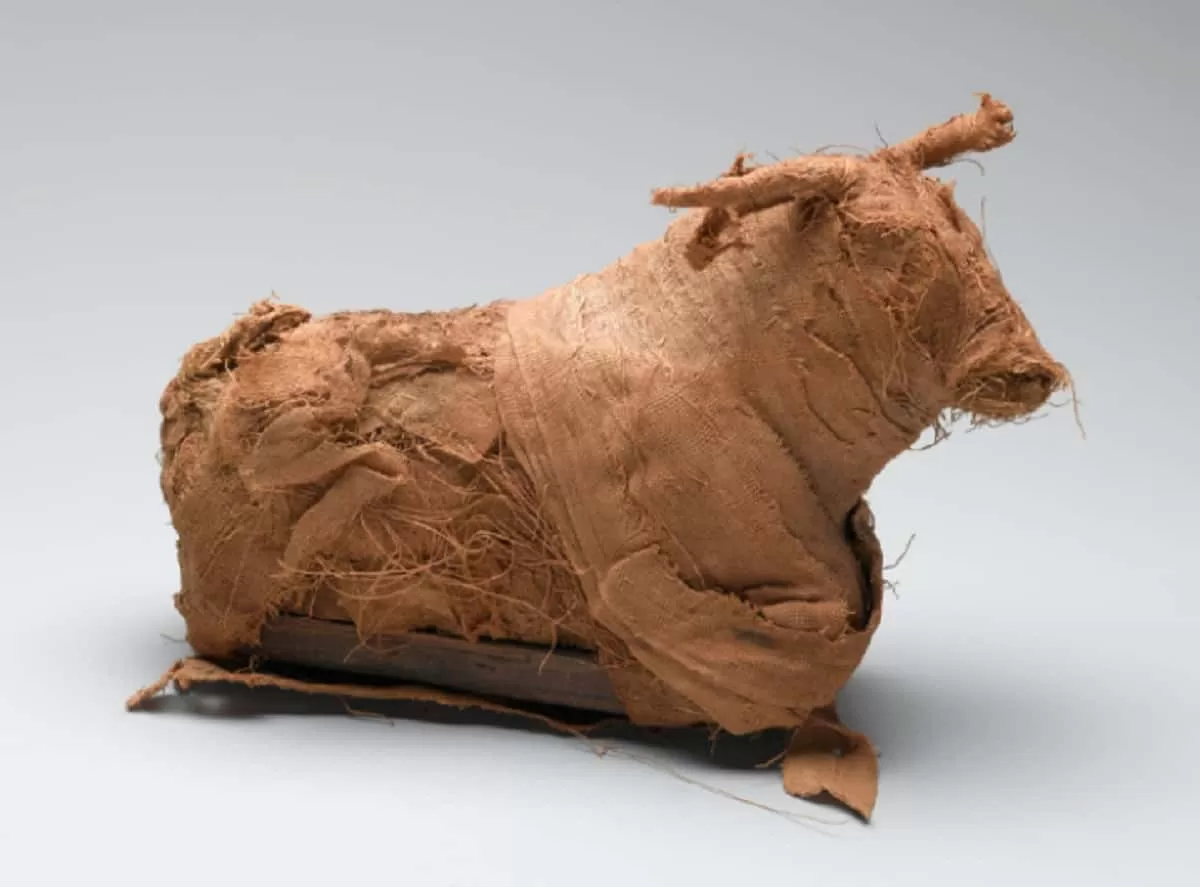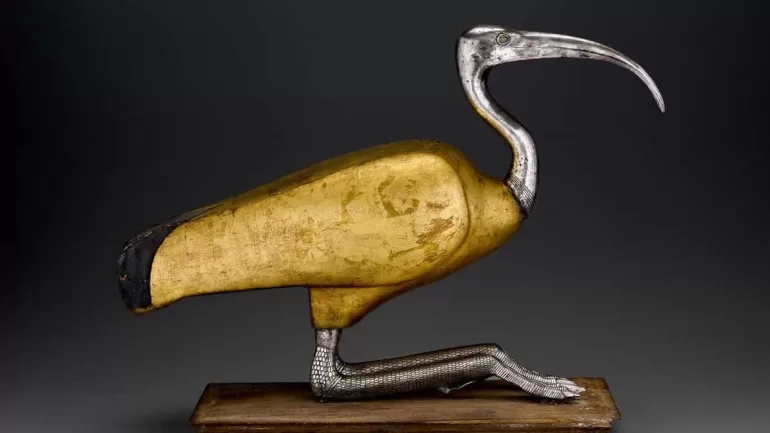ART REVIEW
From ibis coffins to feline mummies, explore animal mummification in ancient Egypt and the sacred rituals hidden beneath linen and gold.
BY KAZEEM ADELEKE, ARTCENTRON
BALTIMORE, MD– Soulful Creatures: Animal Mummies in Ancient Egypt is an acclaimed exhibition at the Walters Art Museum that invites visitors into the fascinating world of animal mummification in ancient Egypt. It offers an immersive journey through how animals transcended mere utility to become spiritual symbols, divine emissaries, and ritual participants. On display are nearly 100 meticulously chosen objects: intricately wrapped mummies, ritual artifacts, ceremonial items, and sculptural pieces. Many come from the Brooklyn Museum’s renowned Egyptian collection, supplemented by ten works from the Walters’ own holdings.
Together, these objects chart the evolution, technique, and cultural significance of animal mummification in ancient Egypt from its earliest incarnations to its height as a sacred industry. The show frames this practice as simultaneously reverent, commercial, and richly symbolic.
Animals as Divine Embodiments and Sacred Messengers
In ancient Egypt, animals occupied every rung of society: they hunted, guarded, labored, and fed communities. Yet their most salient role was spiritual mediation. The Egyptians believed certain species embodied divine essences and were bridges between mortals and gods. In this show, animal mummification in ancient Egypt is not merely a funerary rite but a living theology—an act of communication with the divine.
Each species carried symbolic weight. Cats were sacred to Bastet, goddess of home and fertility; dogs and jackals were associated with Anubis, guide of souls and embalmer of the dead; ibises represented Thoth, god of wisdom and writing; and crocodiles were tied to Sobek, deity of Nile power and regeneration. Birds like falcons had connections to Horus, deities of kingship, while bulls represented strength, and Apis was worshipped as a living manifestation of Ptah. The reverence extended beyond the animals’ lives. Many were interred in temple precincts, mausolea, or sanctuaries as if they were priests or divine intermediaries themselves. Such treatment underscores how animal mummification in ancient Egypt was an act of worship and cosmic order.
The Practice and Scale of Animal Mummification in Ancient Egypt
The tradition of animal mummification in ancient Egypt persisted for over three millennia, from around 3000 BCE until the end of Roman rule in the second century CE. Archaeologists have uncovered millions of mummified animals—cats, dogs, ibises, snakes, fish, monkeys, bulls, and more—across at least 30 dedicated cemeteries.
The motivations behind this large-scale practice were multifaceted and evolved over time.
- Votive offerings and petitions: Worshippers most commonly offered mummified animals to deities to communicate prayers, ask for healing, or gain divine favor. These animals acted as spiritual emissaries carrying written or inscribed petitions. Such demand drove a sacred economy around animal mummification in ancient Egypt.
- Divine incarnations: Egyptians considered some animals living embodiments of gods. After such an animal died, embalmers carefully embalmed and buried it with the same honor given to royalty, elevating its status in the afterlife.
- Companions in the afterlife: In some tombs, animals were sacrificed and entombed alongside their human owners to serve as protectors, companions, or guards in the next world.
- Funerary provisions (“victual mummies”): In certain cases, fish, ducks, or birds were mummified to serve as food ration packages for the deceased’s journey through the afterlife—another dimension of animal mummification in ancient Egypt.
One standout artifact in the exhibition is an ibis coffin (ca. 305–30 BCE), measuring about 16 ¾ × 8 × 22 inches (42.5 × 20.3 × 55.9 cm). Made from wood, silver, gold leaf, gesso, rock crystal, and pigment, it housed a sacred ibis mummy. Scientific analysis suggests the silver head and feet may be later restorations over the original bronze. The coffin is fully gilded and painted, with crystal eyes framed in gold and a carved necklace motif. Such craftsmanship shows the ritual prestige invested in animal mummification in ancient Egypt.
Secrets of Animal Mummification in Ancient Egypt

Another highlight is a model bull from Egypt’s Third Intermediate to Late Period (ca. 1075–332 BCE). Only 5 11⁄16 by 2 7⁄8 by 9 7⁄16 inches (14.5 × 7.3 × 24 cm) and made of reeds and linen, it contains a single bone—maybe from a bull. This underscores that animal mummification in ancient Egypt did not always require whole remains: symbolic fragments wrapped in fine textiles sufficed for ritual meaning.
Techniques and Secrets Revealed by Modern Science
The technical procedures behind animal mummification in ancient Egypt often mirrored those for humans. First, the body goes through the process of desiccation using natron, a dry salt mixture. Next came anointment with oils and resins to preserve flesh and inhibit decay. Wrapping the remains in linen bandages is the step. Sometimes, the linen bandages are beautifully patterned or imbued with protective amulets. After all the preparations, the animal is placed in a coffin or container. Craftsmen shaped some coffins like animals or decorated them with divine iconography, such as that seen on the ibis coffin.
But modern science has revealed layers of complexity—and even deception—beneath the sacred veneer. Through CT scanning, X‑rays, and other noninvasive imaging, researchers have discovered that many mummies were not what they appeared to be. Some contained only partial bones; others were empty, filled only with feathers or resin bundles. In some cases, the species inside did not match the outer wrapping. A celebrated ibis mummy in the show looks ornate, but imaging revealed only a bundle of feathers beneath linen wrappings. In this case, the ritual illusion took precedence over physical substance. In contrast, a simpler feline mummy conceals a complete cat skeleton, wrapped in modest circular linen with a molded linen headpiece. These discoveries show how animal mummification in ancient Egypt straddled belief and commerce, devotion and deception.
Research has also found species substitution—bundles wrapped like ibises might house a cheaper bird or fragments of several animals. This trade in votive mummies sometimes outpaced genuine supply. Scholars believe that some mummification workshops essentially mass‑produced offerings to meet pilgrimage demand. These revelations underscore how animal mummification in ancient Egypt was not only religious but also economic and institutional.
Experience & Scholarly Legacy Soulful Creatures
Soulful Creatures brings this ancient tradition to life through compelling artifacts that merge artistry, ritual, and scientific insight. Visitors can admire complex wrappings, animal‑shaped coffins, votive ossuaries, and symbolic instruments that connect creatures to gods. The exhibition also includes interactive displays showing CT scans and layering of wrapping techniques. These displays help visitors decode what lies within each bundle.
Soulful Creatures: Animal Mummies in Ancient Egypt is the product of robust curatorial collaboration. Yekaterina Barbash (Brooklyn Museum), Edward Bleiberg (Brooklyn Museum), and Lisa Anderson‑Zhu (Walters Art Museum) worked alongside archaeologists, conservators, and imaging specialists to ensure that each piece contributes to a deeper understanding of animal mummification in ancient Egypt. The accompanying catalog, Soulful Creatures, provides essays on ritual logic, imaging studies, and iconographic interpretations.
More than a static display, this exhibition invites reflection on human–animal relationships across time. It emphasizes that for ancient Egyptians, animals were not subordinate creatures but spiritual companions, cosmic vessels, and communicators to realms unseen. In spotlighting animal mummification in ancient Egypt, Soulful Creatures bridges ancient belief systems and modern science, reminding us how civilization’s deepest imaginaries often arise from encounters with the nonhuman.
- Featured Image: Ibis Coffin (Thoth), 305–30 B.C.E. Wood, silver, gold leaf, gesso, rock crystal, pigment, 16 3/4 x 8 x 22 in. (42.5 x 20.3 x 55.9 cm). Brooklyn Museum, Charles Edwin Wilbour Fund, 49.48a-b. (Photo: Brooklyn Museum (Gavin Ashworth, photographer))
Soulful Creatures: Animal Mummies in Ancient Egypt continues through January 11, 2026. Walters Art Museum, 600 N. Charles St., Baltimore, MD 21201.
